Weather events often integrate into the culture of specific regions. Those living along the coastlines likely have hurricanes they remember, or hurricanes that have impacted the region long ago. Oklahoma and Kansas have stories from ancestors of tornadoes, hail, and other severe storms. While in the northern plains of Nebraska, the Dakotas, and Minnesota, it's blizzards that take over the weather tragedies that stick with us through generations.
Many people who live in this region have at least heard of the Schoolchildren's Blizzard of January 12, 1888. From the stories passed down from generation to generation, to a mural inside the Nebraska state capitol building today, the blizzard of 1888 is one that has been integrated into the culture of the Prairie. In this week's installment of This Week in Weather History we look at the Blizzard of 1888, the meteorology behind the storm, the stories of heroic efforts and tragic ends, and the storm which left an imprint on those living in the region today.
(NOTE: In 1888, what is today North and South Dakota was still one territory, the Dakota territory. North and South Dakota won't be states for another year. Therefore, the term "Dakota" will be used in this blog)
NEBRASKA IN 1888
In 1862, in the midst of the Civil War, President Abraham Lincoln signed into law the Homestead Act. The act stated that anyone who applied was given 160 acres of free land in the western frontier. The passing of the Homestead Act set the conditions for the "Great Dakota Boom" where thousands of people packed up and moved out west from the 1860s through the 1880s.
The Dakota Boom also saw a significant population rise in Nebraska too as pioneers sought a better life out in the open prairie. A state since 1867, the population of Nebraska exploded from around 30,000 in 1860; to 122,000 in 1870; to 452,000 in 1880; and reaching over 1,000,000 by 1890. Omaha saw a similar rise in population, from a town of around 1,000 in 1860 to 140,000 in 1890.
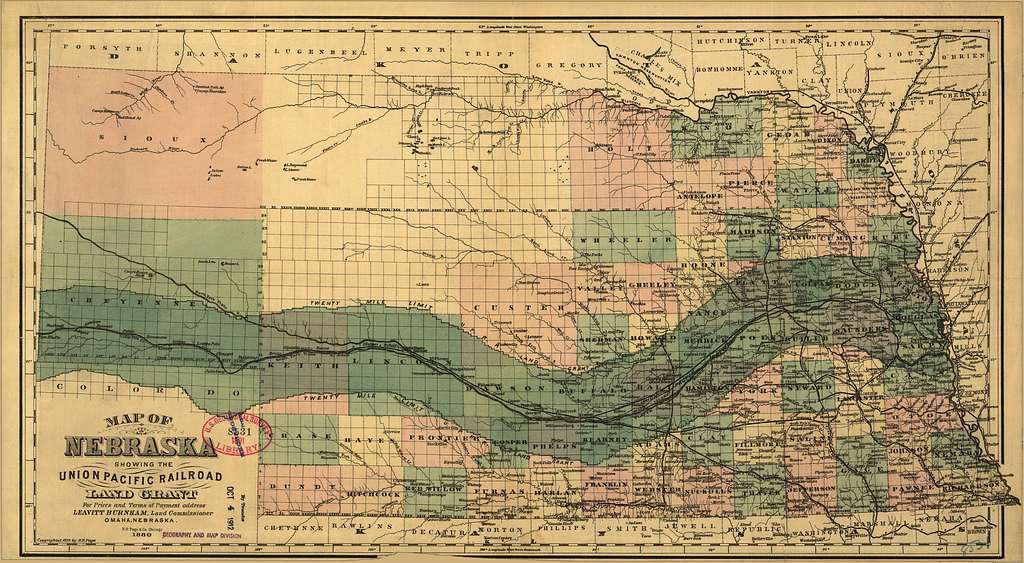
Life on the frontier in Nebraska and Dakota was rough to say the least. Many settlers lived in sod houses, which did a remarkable job insulating the home during the scorching summer months and brutal winter months. Grass fires often burned wide swaths of prairie. Locusts would swarm, devouring everything in sight. For the pioneer living in Nebraska in 1888, life was brutal, but at least they escaped the plague, filth, and other horrors of the cities.

Perhaps above all else, the weather was like no other in the country. Spring led to severe thunderstorms, giant hail, and tornadoes. Summer was scorching. Autumn brought beneficial rains, sometimes flooding as in spring. However, it was the winters which brought the fury. Temperatures frequently plunging below zero for days in a row, blizzards creating whiteout conditions, among other things. Those that moved to Nebraska in the 1870s experienced firsthand a plains winter, in 1880-1881 repeated snowstorms brought the region to a standstill on several occasions. No one was ready for the plight that Nebraska and Dakota would face on January 12, 1888.
THE COLD FRONT
Between January 6 to January 11, 1888, it was quite cold over the northern plains. High temperatures in Omaha hardly got above zero in many spots, while those in central Nebraska remained in the negatives for nearly a week.

Between January 10 and January 12, a low-pressure system was strengthening in Canada and diving south into the United States.
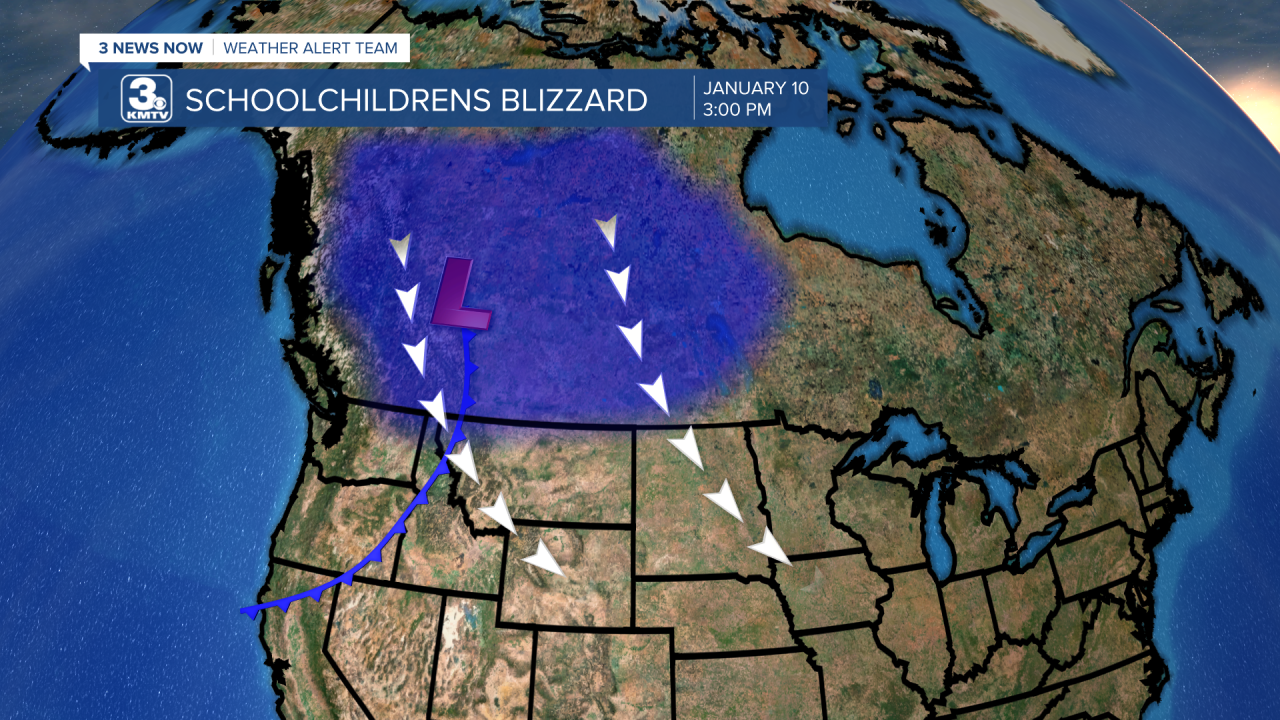

On the morning of January 12, temperatures across Nebraska and Dakota were mild. Omaha was at 28 above zero, a stark contrast to the negatives just the day before. Sensing the day to be mild, many children went off to school that day after not going for several days, some did not bring gloves or other winter gear. This deceptive warmth in the morning proved to be fatal to many.
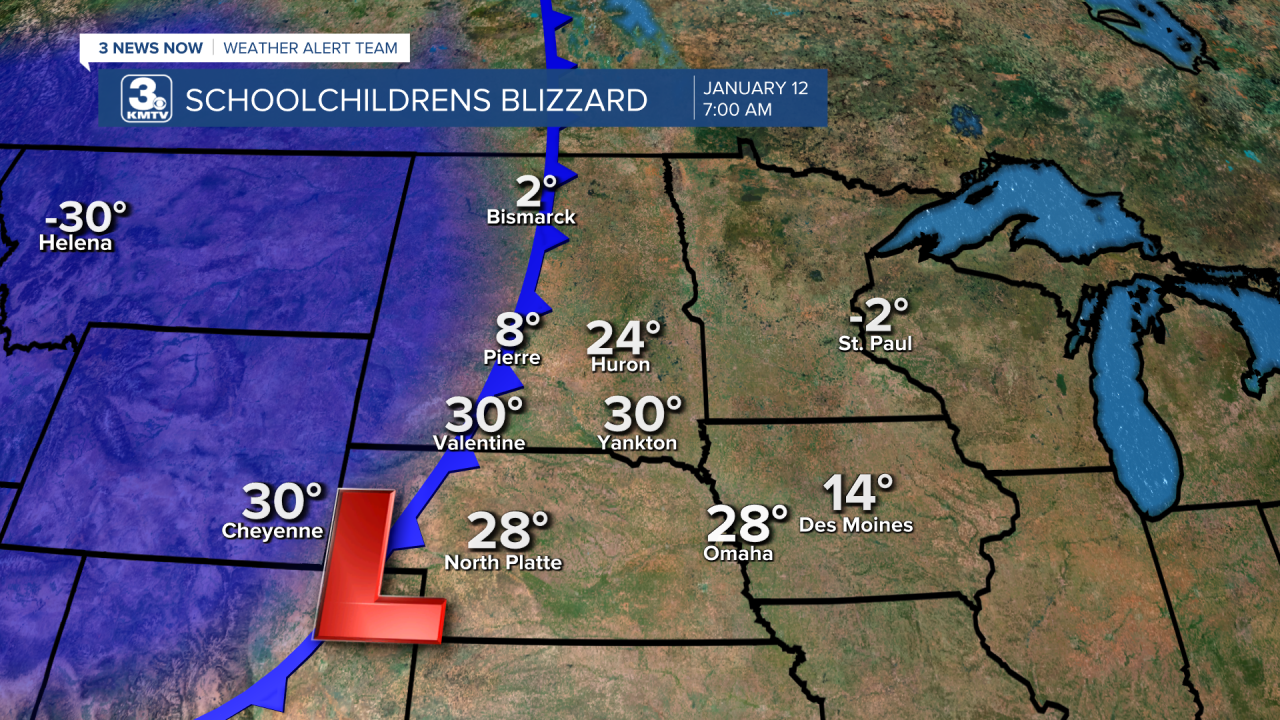
The cold front came crashing down through the late morning into the afternoon. By 11am, the front had passed through Yankton, SD, where the temperature dropped 18 degrees in just 3 minutes! The snow fell almost immediately, many accounts talked about the suddenness of the calm day turning into chaos as snow fell in torrents while the winds gusted over 60 mph.

Whiteout became common across Nebraska and Dakota. Picture yourself standing in the snow, where you can hardly see your hand in front of you. Now add in the snow getting in your eyes, freezing to your skin in the cold, and a wind so strong it's hard to stand up. That is a taste of what those who were outside when the blizzard roared in suddenly. Those who were only a few feet from their homes lost sight of shelter, many wandering around aimlessly in the whiteout conditions.

Most tragic of all was what happened in the schoolhouses. When the blast of the blizzard hit, lessons immediately halted as teachers figured out what to do. Some teachers opted to keep their pupils indoors, burning desks and other objects to stay warm. Unfortunately, others either dismissed the students or ventured out to find shelter, students in tow. Many children got lost in the blinding abyss of snow, and subsequently froze. All across Nebraska and Dakota, those caught outside became victims in the brutality of the cold and snow.
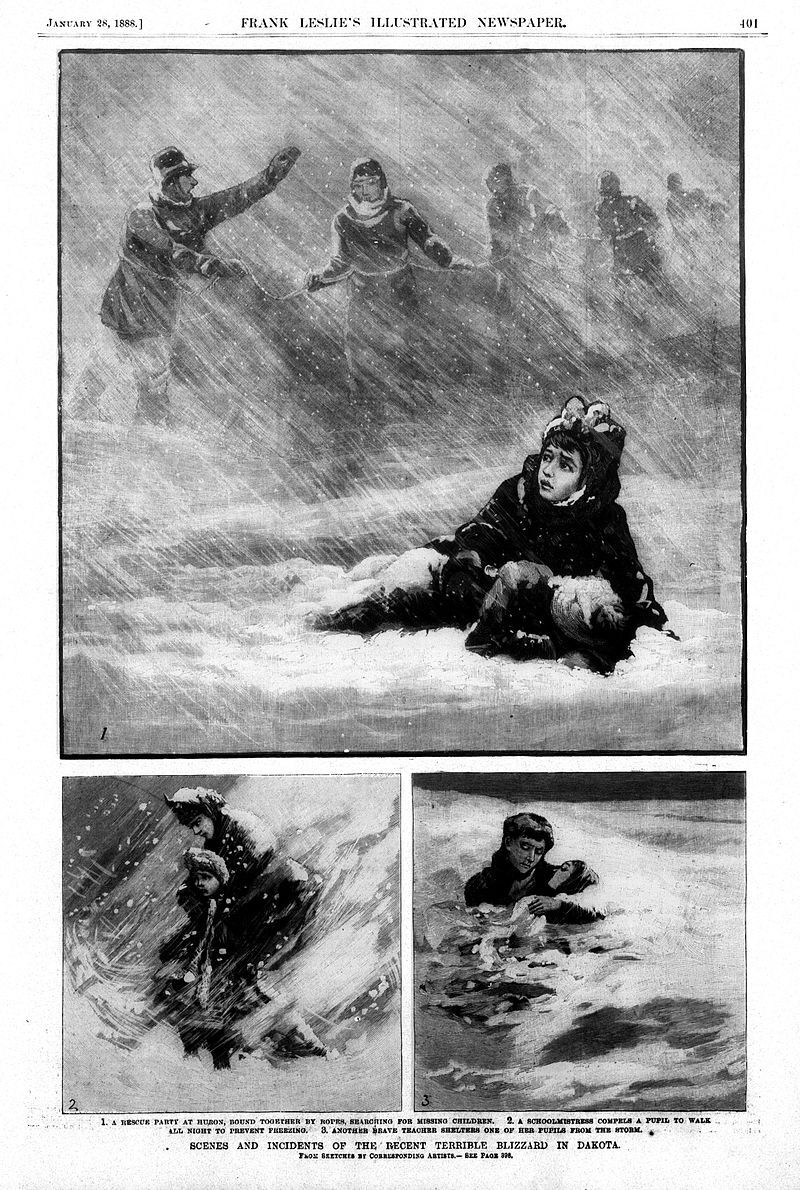
THE STORIES OF NEBRASKA'S WORST BLIZZARD
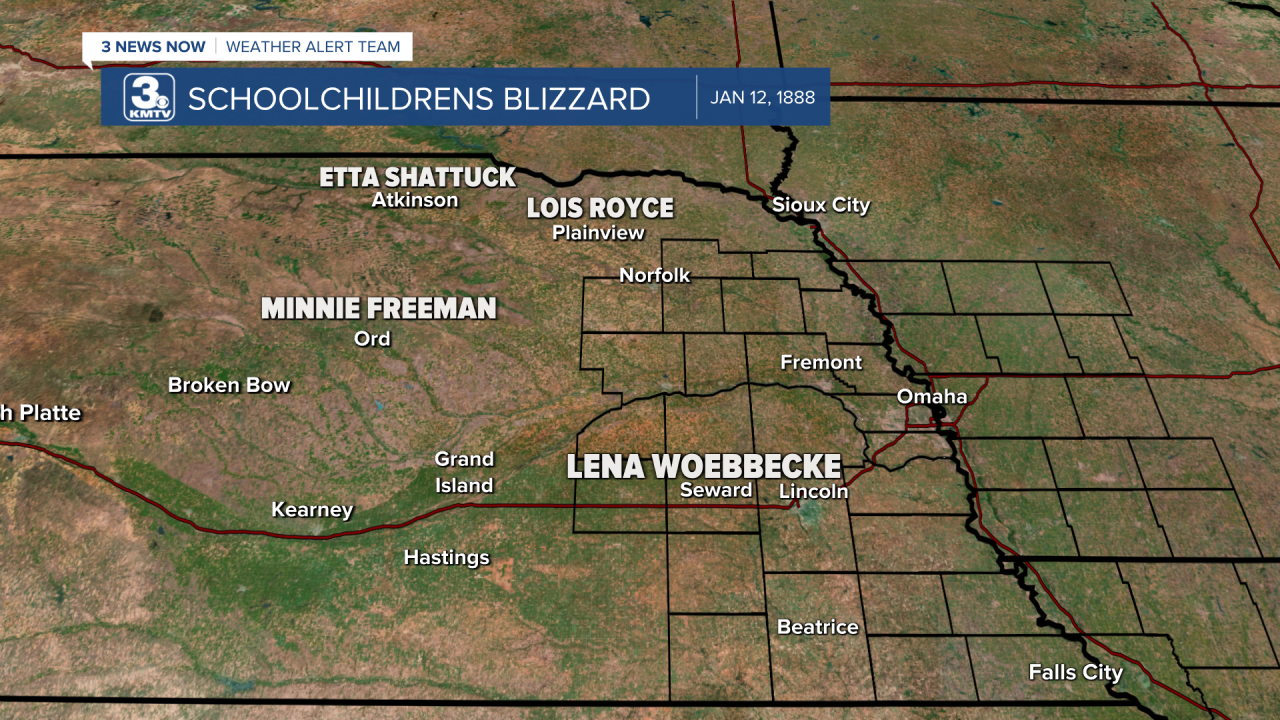
Minnie Freeman - Near Ord, in central Nebraska, 19-year-old Minnie Freeman was teaching class when the blizzard swept in. She knew her schoolhouse was not the safest place for them, made a reality when the strong winds blew off the roof to the school. With her 13 children, Minne Freeman brought them to her home a mile and a half away in the blinding cold. Legend has it that she led the students with a rope, although there are conflicting accounts as to whether that was true or not. Nevertheless, Minnie Freeman still saved the lives of all 13 students, and has become the posterchild of the blizzard of 1888. She received over 80 marriage proposals in the wake of the storm, and her story has been immortalized so much so that there is a mural of her leading the children in the blizzard in the capitol building.


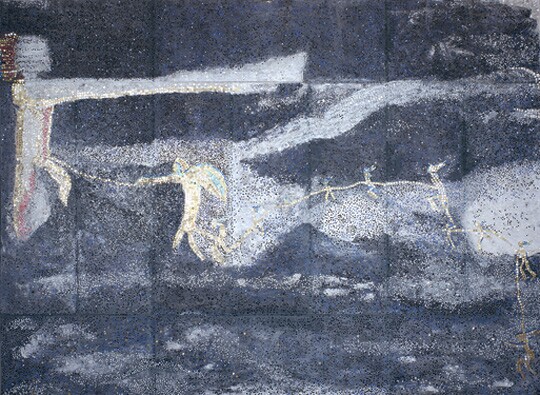
Lois Royce - In Plainview, Nebraska, near Norfolk, schoolteacher Lois Royce still had three children in her school when the blizzard struck. Knowing there was not enough fuel in the schoolhouse, she led her three children outdoors. The shelter was only less than 100 yards away, but the teacher lost her way in the torrent of snow. Forced to shelter in the open, the schoolteacher held onto her three students as they froze to death in the open. Royce barely survived, losing her feet in the process. Despite the loss of the children, Royce was still hailed as a heroine by her effort to save her students.
Lena Woebbecke - Lena led a tragic life before the blizzard of 1888. She was five when her father died of smallpox in 1882, her being infected with it leaving her face scarred. Her mother sent her to live with another family outside Seward. Like many children that fateful afternoon, Lena was caught outside when the blizzard pounced. She was found hours later curled up, nearly on death's door, but she was found in time. Her foot was amputated, and Lena learned to walk with a wooden foot for the rest of her life. She got married in 1901, but unfortunately passed away a year later at age 25.
Etta Shattuck - Also from Seward, Etta was a teenage schoolteacher working in Atkinson in Holt County, outside of O'Neill. She was set to go back to Seward the following day, only at the schoolhouse to collect her paycheck. As she was walking home, the blizzard slammed into Holt County, blinding her on her way home. Etta managed to find a haystack, where she burrowed herself in enough to escape the unrelenting cold. She was out there for almost 70 hours, nearly 3 days without food or water before being rescued. Barely alive, Etta was brought back to her parents' home in Seward where she underwent surgery for her foot, lost in the blizzard. Due to medical practice in the 19th century being what it was, Etta developed an infection from her foot wound, which took her life in early February. The story of Etta, the girl who survived 70 hours in a haystack, caught national attention.

These are only a few of the many stories of survivors, and those who did not, from the blizzard of 1888. Estimates on the loss of life, the low numbers are around 200 while some reach close to 1000. The blizzard captured headlines across the nation and brought the communities of Nebraska and Dakota together. Nowadays, the Schoolchildren's Blizzard of 1888 remains ingrained in the culture of Nebraska as a testament to the ferocity of mother nature.

SOURCES
- The Childrens Blizzard by David Laskin
- Nebraska State Historical Society
- NWS Rapid City




